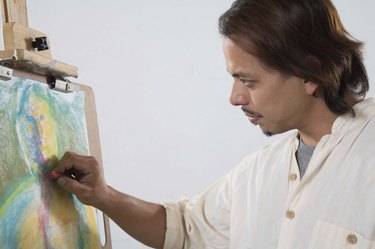Things You'll Need
Canvas
Drawing tools
Colored pencils
Soft pastels
Oil pastels
Watercolor pencils
Charcoal
Graphite pencils
Blending stump
Spray bottle
Water
Sponge
Spray fixative

Use pastels, charcoal or pencils to draw on canvas, creating dramatic, unusual and beautiful effects. Different drawing materials create a variety of subtle or bold texture effects. The primary types of materials used to draw on canvas are graphite pencils, pigment-based colored art pencils, watercolor pencils, soft and oil pastels, and charcoal. Graphite pencils can be used to draw on canvas, but must be sealed with a fixative before they are permanent.
Prepare the Canvas and Materials
Step 1
Wash the canvas with a sponge and clean water.
Video of the Day
Step 2
Allow the canvas ample time to dry before you begin to draw on it.
Step 3
Sketch the outlines or basic forms and relationships of your desired imagery on the canvas with a soft graphite pencil. Erase any unwanted marks from the canvas with a clean, wet sponge or cloth. Continue with the drawing until you are satisfied with the basic composition of the preliminary sketch.
Drawing With Colored Pencils on Canvas
Step 1
Draw lighter and mid-tone areas of the image before you begin to draw darker areas. Allow the white color of the canvas to show through for highlights. Also, assess color depth and luminosity created by the "tooth" of the canvas as you begin to draw. The tooth refers to the amount of texture created by the underlying canvas fibers.
Step 2
Drawing with darker pencil colors around highlighted forms to establish negative space.
Step 3
Complete the detailed areas.
Drawing With Soft Pastels and Charcoal on Canvas
Step 1
Create broad mid-tone areas in your drawing using the side of a soft pastel or charcoal. Leave highlight areas white or blank.
Step 2
Fill a spray bottle with clean water. Spray a fine mist over the mid-tone areas and allow them to dry before continuing with your drawing.
Step 3
Complete darker-toned areas of your drawing with the tip of a soft pastel or charcoal.
Step 4
Spray a fine mist of water over the darker-toned areas of your drawing and allow them to dry.
Step 5
Draw detailed areas with the edge of the charcoal, a thin stick of vine charcoal, or soft pastels.
Step 6
Spray the completed drawing with workable fixative or varnish.
Drawing With Oil Pastels on Canvas
Step 1
Draw the basic dark areas of your composition first before beginning to draw mid-tones.
Step 2
Draw mid-tone areas of your composition using brighter colors.
Step 3
Blend mid-tone colors with dark areas using your finger or a blending stump. Add brightness to mid-tone areas with white or bright yellow.
Step 4
Complete darker detailed areas of your composition with dark pastels. Use Payne's grey or sepia for depth of detail.
Step 5
Complete lighter, highlighted, detailed areas with white oil pastel.
Step 6
Spray the final composition with varnish or fixative.
Tip
Use prepared canvases that are coated with a material called gesso, which is an acrylic-based underpainting or coating that protects the underlying canvas fibers from deterioration. Drawing or painting directly on uncoated canvas will cause the canvas to deteriorate quickly from mold and mildew.
Place source images within comfortable view of your work area. Source images include photographs, models, or magazine images.
Drawing outside is called plein air. Ensure your canvas and materials are located safely and conveniently if you intend to draw a plein air landscape on your canvas.
The texture of colored pencil marks on canvas will be bolder than the texture obtained when drawing on paper.
Work from right to left if you are left-handed. Work from left to right if you are right-handed.
Avoid smearing and muddying colors by completing an entire segment of the drawing before moving to the next segment.
Soft pastels have similar properties to compressed sticks of charcoal. Both types of drawing tools create dust and can smear when applied to canvas.
Place completed charcoal, soft pastel and oil pastel drawings on canvas under plexiglass or glass to prevent smearing.
Smooth, completely covered canvas areas can be achieved by drawing with oil pastels on canvas.
Oil pastels are made from pigment, a small amount of linseed oil and a wax binder. Traditional oil pastels will never dry because of their composition.
Warning
Drawings on canvas are not permanent unless a fixative or other type of varnish is applied. Oil pastel and soft pastel drawings should be placed under plexiglass or glass to prevent smearing.
Video of the Day